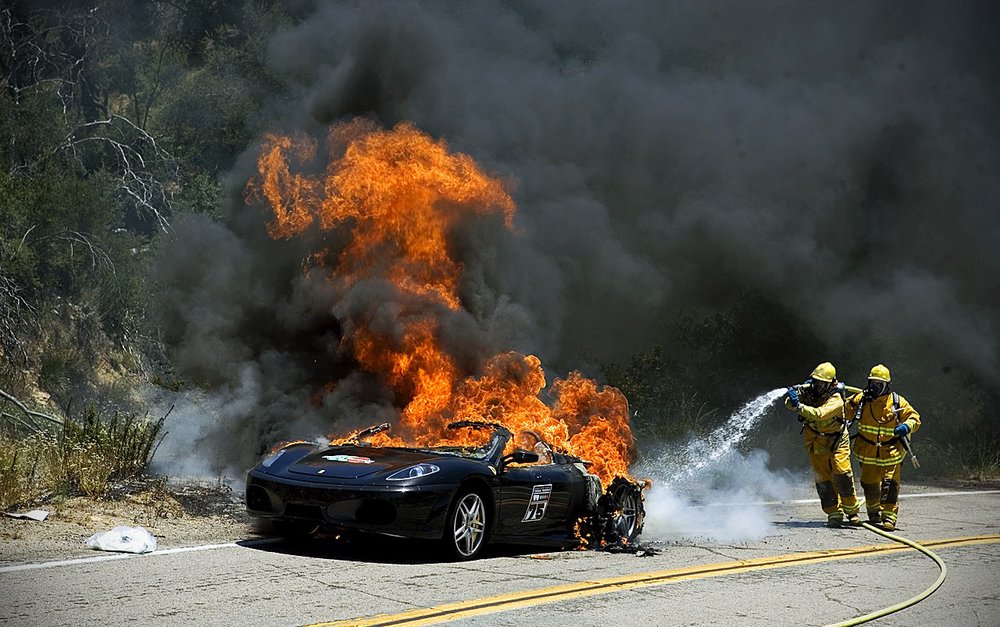AUTONEWS

Electric vs gasoline: Which is the most incendiary?
The unfortunate consequences are known when there are fires involving a generous amount of vehicles, in tunnels and underground garages. It will suffice to remember, for example, that what took place in the Monte Branco tunnel in 1999, involving about 40 cars and trucks running on gasoline or diesel, caused the death of 35 people, including drivers and passengers. Although companies that build tunnels and underground garages have to meet requirements so that these infrastructures are prepared to deal with the possibility of a fire with vehicles with combustion engines, the growing number of electric vehicles, powered by battery, leads to that it is increasingly important to know what happens when batteries, not petroleum products, are burning. And that is exactly what the Federal Materials Research and Testing Institute (EMPA) wanted to determine, financed by the Swiss Federal Roads Directorate (ASTRA). The study was carried out in December 2019, but only in August were the data published.
In order to respond to the operators of these partially enclosed spaces, where ventilation is not always the best and visibility much less, especially when smoke invades the place, the project coordinator, Lars Derek Mellert, from the consultancy Amstein + Walthert Progress AG, helped from the Swiss test tunnel of Hagerbach AG, where three types of tests were carried out.
Three tests to get everything clean
To simplify the tests in the test tunnel, the Swiss technicians have chosen to reduce the battery pack to just 4 kWh, 1/8 of the desired capacity (32 kWh), representing the accumulator pack to which a small utility uses. As could be expected, the space inside the tunnel was also reduced by the same proportion.
The first test consisted of setting the battery module on fire and studying the quantity and distribution of smoke and soot, both the main cause that leads to suffocating those trapped in the tunnels, and still preventing them from finding a way out. The vehicle's plastics, as well as the interior linings and tires, will still raise the difficulties but, although they were not mentioned in the study, we believe that experts have considered that they will be similar to those that characterize cars with combustion engines.
The second test aimed weapons at what happens after firefighters attacked the fire, analyzing the chemicals left in the water used to extinguish the fire. Finally, the third test focused on the ventilation system, as well as the amount and type of waste that remains in the ducts.
And the conclusions?
For Swiss technicians, pollutant emissions released during a fire, regardless of the type of vehicle and fuel, are always dangerous and often fatal. But over the course of the three tests carried out, experts found that electric vehicles are no more dangerous than those that mount combustion engines, whether they are gasoline or diesel.
The fire that consumes the battery cells releases corrosive and toxic gases, somewhat similar to what happens with petroleum-based fuels, with the conclusion, after the three tests carried out, that in no case were they above the critical limit and, therefore, they cannot be considered dangerous.
The tests carried out also have conclusions that are of interest to tunnel operators and garages. Experts say that the current standards, in terms of ventilation, have proved to be sufficient to deal with the smoke caused by the burning of batteries or fossil fuels, being essential that they are fully respected to guarantee breathable air inside the infrastructures in case of to avoid the repetition of the Monte Branco tunnel drama.
However, technicians still call attention to the fact that, after a fire, it is essential to proceed with the complete cleaning of the installations, since the soot caused by the batteries, rich in nickel, cobalt and manganese oxides, lines the floor, walls, ceiling and ducts. Equally dangerous is the water used to extinguish the fire. The analyzes showed that the chemical concentration exceeds the limit imposed for industrial wastewater in Switzerland by 70 times, with the tanks used to immerse electric vehicles in water, in order to ensure that the fire does not reignite, even reaching values 100 times over the limit.
In summary, the Swiss study proved that electric cars are no more dangerous than those that mount combustion engines, both of which emit toxic gases and amounts of smoke and soot that can be fatal. This advises that, as soon as a fire breaks out in a tunnel or garage, the first concern of drivers and passengers should be to leave the place as quickly as possible, instead of waiting to see how the situation will evolve.
For those responsible for combating flames, the alert remains that the smoke attached to the interior of the infrastructure is extremely toxic, so it must be cleaned and decontaminated by teams prepared to deal with this type of pollutants. They must also pay attention to the water used to extinguish the flames, since the level of contamination is particularly high.

Nenhum comentário:
Postar um comentário